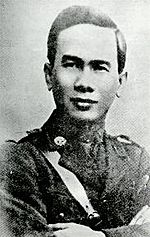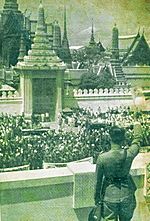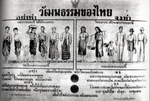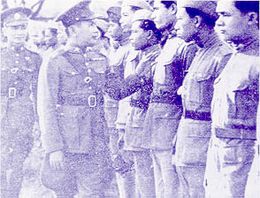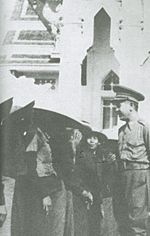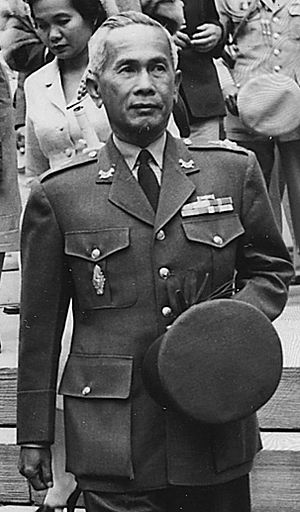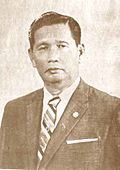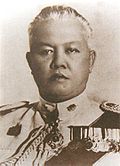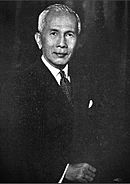Plaek Phibunsongkhram facts for kids
Quick facts for kids
Plaek Phibunsongkhram
PChW MPCh MWM NR GCS GCMG
|
|
|---|---|
| แปลก พิบูลสงคราม | |
 |
|
| Prime Minister of Thailand | |
| In office 8 April 1948 – 16 September 1957 |
|
| Monarch | Bhumibol Adulyadej |
| Deputy |
See list
Fuen Ronnaphagrad Ritthakhanee
Prayoon Yuthasastrkosol Worakarn Bancha Phin Choonhavan Sawat Sawatdironnachai Sawatdikea |
| Preceded by | Khuang Aphaiwong |
| Succeeded by | Pote Sarasin |
| In office 16 December 1938 – 1 August 1944 |
|
| Monarch | Ananda Mahidol |
| Deputy |
See list
Adul Aduldetjarat
Chaweng Saksongkhram |
| Preceded by | Phraya Phahonphonphayuhasena |
| Succeeded by | Khuang Aphaiwong |
| Minister of Defence | |
| In office 28 June 1949 – 26 February 1957 |
|
| Prime Minister | himself |
| Preceded by | Suk Chatnakrob |
| Succeeded by | Sarit Thanarat |
| In office 22 September 1934 – 15 November 1943 |
|
| Prime Minister | Phot Phahonyothin himself |
| Preceded by | Phot Phahonyothin |
| Succeeded by | Phichit Kriangsakphichit |
| Minister of Foreign Affairs | |
| In office 15 December 1941 – 19 June 1942 |
|
| Prime Minister | himself |
| Preceded by | Direk Jayanama |
| Succeeded by | Luang Wichitwathakan |
| Minister of Agriculture and Cooperatives | |
| In office 12 September 1957 – 16 September 1957 |
|
| Prime Minister | himself |
| Preceded by | Siri Siriyothin |
| Succeeded by | Wiboon Thammaboot |
| Minister of Culture | |
| In office 12 September 1957 – 16 September 1957 |
|
| Prime Minister | himself |
| Preceded by | position establish |
| Succeeded by | Pisan Sunavinvivat |
| Minister of Commerce | |
| In office 4 February 1954 – 23 March 1954 |
|
| Prime Minister | himself |
| Preceded by | Boonkerd Sutantanon |
| Succeeded by | Siri Siriyothin |
| Minister of Finance | |
| In office 13 October 1949 – 18 July 1950 |
|
| Prime Minister | himself |
| Preceded by | Prince Vivatchai Chaiyant |
| Succeeded by | Chom Jamornmarn |
| Minister of Interior | |
| In office 13 October 1949 – 18 July 1950 |
|
| Prime Minister | himself |
| Preceded by | Thawan Thamrongnawasawat |
| Succeeded by | Chuang Kwancherd |
| Minister of Education | |
| In office 1942–1942 |
|
| Prime Minister | himself |
| Preceded by | Sindhu Kamolnavin |
| Succeeded by | Prayun Phamonmontri |
| Supreme Commander of the Armed Forces | |
| In office 13 November 1940 – 24 November 1943 |
|
| Preceded by | position established |
| Succeeded by | Sarit Thanarat |
| Commander in Chief of the Royal Thai Army | |
| In office 4 January 1938 – 5 August 1944 |
|
| Preceded by | Phraya Phahonphonphayuhasena |
| Succeeded by | Phichit Kriangsakphichit |
| Personal details | |
| Born | 14 July 1897 Mueang Nonthaburi, Nonthaburi, Siam |
| Died | 11 June 1964 (aged 66) Sagamihara, Kanagawa, Japan |
| Nationality | Thai |
| Political party | Seri Manangkhasila Party (1955–57) |
| Other political affiliations |
Khana Ratsadon (1927–54) |
| Spouse | La-iad Bhandhukravi |
| Children | 6, including Nitya |
| Signature | |
| Military service | |
| Allegiance | |
| Branch/service | |
| Years of service | 1914–1957 |
| Rank | |
| Commands | Supreme Commander |
| Battles/wars |
|
Plaek Phibunsongkhram (Thai: แปลก พิบูลสงคราม), often called Phibun, was an important Thai military officer and politician. He served as the Prime Minister of Thailand for two periods: from 1938 to 1944 and again from 1948 to 1957. He was a very strong leader, sometimes called a dictator.
Phibun was part of the Khana Ratsadon (People's Party), Thailand's first political group. He helped lead the Siamese revolution of 1932. This event changed Thailand from a country ruled by a king with absolute power to a constitutional monarchy, where the king's power is limited by a constitution.
As Prime Minister, Phibun focused on making Thailand more modern and promoting Thai nationalism. He even changed the country's name from "Siam" to "Thailand." During World War II, he made an alliance with Japan. After the war, he returned to power and sided with countries against communism during the Cold War. Phibun is the longest-serving Prime Minister of Thailand, holding the position for over 15 years.
Contents
Early Life and Military Career
Plaek Khittasangkha was born on July 14, 1897, in Nonthaburi Province, Siam. His parents owned a durian orchard. He was given the name "Plaek," which means 'strange' in English, because of his unusual appearance as a child.
Plaek studied at Buddhist temple schools before joining the Chulachomklao Royal Military Academy. He graduated in 1914 and became a second lieutenant in the artillery. After World War I, he went to France to study military tactics. In 1928, he received the noble title Luang from King Prajadhipok and became known as Luang Phibunsongkhram. He later dropped the "Luang" title but kept Phibunsongkhram as his last name.
The 1932 Revolution
In 1932, Phibun was a key leader in the Khana Ratsadon group. This group carried out a coup d'état (a sudden takeover of government) that ended the king's absolute rule in Siam. They replaced it with a constitutional monarchy, giving more power to the government and people. Phibun, then a lieutenant colonel, quickly became well-known in the military.
The next year, Phibun and other military officers stopped the Boworadet Rebellion. This was a revolt by royalists who wanted the old system back. Even though King Prajadhipok wasn't involved, this event led to him giving up his throne. King Ananda Mahidol, who was a child studying in Switzerland, became the new king in 1935.
Becoming Prime Minister of Thailand
On December 16, 1938, Phibun became the Prime Minister of Thailand. He also became the head of the Royal Siamese Army. He quickly gained a lot of power, becoming the de facto (in practice) leader of Thailand. He gave important jobs in his government to his military friends.
Phibun admired the Italian fascist movement led by Benito Mussolini. He used similar methods, like strong government propaganda, to promote his ideas. He wanted to strengthen Thai unity and pride. Photos of Phibun were everywhere, and his words were printed in newspapers and broadcast on the radio.
Thai Cultural Revolution
Phibun strongly promoted Thai nationalism. He started a series of big changes called the Thai Cultural Revolution to modernize Thailand quickly. He wanted to improve the country's spirit and moral values.
His government issued several "cultural mandates." These rules encouraged Thais to:
- Salute the flag in public.
- Learn the new national anthem.
- Use the standard Thai language, not local dialects.
- Wear Western clothes instead of traditional ones.
- Eat with a fork and spoon instead of their hands.
Phibun believed these changes were important to make Thailand seem modern and civilized to other countries.
Phibun's government also promoted economic nationalism. This meant encouraging Thais to buy Thai products. They also had strong feelings against Chinese people living in Thailand, even though Phibun himself had some Chinese family history. Policies were put in place to reduce the economic power of the Chinese minority.
On June 24, 1939, Phibun officially changed the country's English name from "Siam" to "Thailand." He felt that "Siam" was a foreign name that didn't fit his nationalist goals. In 1941, he also changed the start of the new year to January 1st, instead of the traditional April 13th.
Franco-Thai War
In 1940, when France was weakened by World War II, Phibun saw a chance for Thailand to get back territories that France had taken earlier. Thailand fought against Vichy France from October 1940 to May 1941. Thailand's military was stronger and invaded French Indochina.
Even though Thailand was winning, Japan stepped in to help make a peace agreement. France was forced to give the disputed lands to Thailand. This was seen as a victory for Thailand, but it also meant that Japan, which was expanding quickly, now shared a border with Thailand.
Alliance with Japan in World War II
Phibun was generally supportive of Japan, but he also felt threatened by their growing power. When Japan invaded Thailand on December 8, 1941, Phibun reluctantly ordered a ceasefire after one day. He allowed Japanese armies to use Thailand as a base to invade British colonies like Burma and Malaya.
After seeing Japan's quick victories, Phibun signed a military alliance with Japan on December 21. The next month, on January 25, 1942, Thailand declared war on Britain and the United States. Phibun removed anyone from his government who opposed the alliance with Japan. The United States saw Thailand as being controlled by Japan and did not declare war on it. This helped Thailand later when the Allies won the war.
End of First Term
In 1944, as Japan was losing the war, the National Assembly removed Phibun from his position as prime minister. His six years as military commander ended. His removal was partly due to his unpopular plans, like moving the capital to a remote jungle area during a difficult economic time.
Khuang Aphaiwong replaced Phibun. After the war, Phibun was put on trial for working with the Axis powers (Japan and Germany). However, he was found not guilty because many people still supported him. They believed he had done his best to protect Thailand's interests.
Second Term as Prime Minister
In November 1947, military units loyal to Phibun carried out another coup d'état. They forced the prime minister to resign. On April 8, 1948, Phibun became Prime Minister again.
His second time as prime minister was different. He stopped using the strong, fascist-like style of his first term. Instead, he tried to present Thailand as a democracy. With the start of the Cold War, Phibun aligned Thailand with the countries against communism. Thailand received a lot of aid from the United States after joining the Korean War as part of the United Nations Command.
Phibun also restarted his policies against Chinese people in Thailand. The government limited Chinese immigration and tried to reduce their economic influence. Chinese schools and groups were closed down again.
In 1955, Phibun traveled to the United States and Europe. He was very impressed by the freedom of speech he saw there. He even set up a "Speakers' Corner" in Bangkok, like Hyde Park in London, where people could speak freely. Phibun began to make Thailand more democratic by allowing new political parties and planning free elections. He even started his own political party, the Seri Manangkhasila Party.
Challenges to Power
Phibun's second term faced many challenges and attempts to remove him from power. Unlike his first term, he had strong opposition, even from within the military.
- Army General Staff Plot (1948): Some army officers tried to overthrow his government, but they failed. Many officers and supporters of his old rival, Pridi Phanomyong, were arrested.
- Palace Rebellion (1949): Another attempt to remove Phibun happened when rebels tried to take over the Grand Palace in Bangkok. Fighting broke out between rebels and loyal soldiers, lasting over a week.
- Manhattan Rebellion (1951): Phibun was taken hostage by navy officers on a US ship. Negotiations failed, and fighting started in Bangkok. Phibun managed to escape by swimming to shore when his captors' ship was bombed. The navy then surrendered.
- Silent Coup (1951): A group of military leaders staged a "silent coup." This strengthened the military's control over the country. It brought back an older constitution that gave more power to the government and military officers.
Overthrow and Later Life
In February 1957, public opinion turned against Phibun. His party was accused of cheating in an election, including intimidating opponents and buying votes. People also criticized him for not showing enough respect for the Thai monarchy. He tried to limit the king's role and took on religious duties that traditionally belonged to the monarch.
On September 16, 1957, Phibun was overthrown in a coup d'état by the Royal Thai Army, led by Field Marshal Sarit Thanarat. Sarit had previously sworn loyalty to Phibun. Many royalists supported Sarit, hoping to regain influence.
After the coup, Phibun was forced to leave Thailand. He first fled to Cambodia and then settled in Japan. In 1960, he briefly became a monk in a Buddhist temple in India.
Death
Plaek Phibunsongkhram died on June 11, 1964, from heart failure while in exile in Sagamihara, Japan. After his death, his ashes were brought back to Thailand in an urn and honored with military ceremonies at Wat Phra Sri Mahathat, a temple he had founded.
Honours
Military Ranks
- 1916 - Second Lieutenant
- 1920 - Lieutenant
- 1927 - Captain
- 1930 - Major
- 1933 - Lieutenant Colonel
- 1934 - Colonel
- 1939 - Major General, Rear Admiral, Air Vice Marshal
- 1941 - Field Marshal, Admiral of the Fleet, Marshal of the Royal Thai Air Force
- 1955 - Volunteer Defense Corps General
Thai Decorations
Plaek Phibunsongkhram received many honors from Thailand, including:
- 1937 -
 Knight Grand Cordon (Special Class) of The Most Noble Order of the Crown of Thailand
Knight Grand Cordon (Special Class) of The Most Noble Order of the Crown of Thailand - 1940 -
 Knight Grand Cordon (Special Class) of The Most Exalted Order of the White Elephant
Knight Grand Cordon (Special Class) of The Most Exalted Order of the White Elephant - 1941 -
 Knight of The Ancient and Auspicious Order of the Nine Gems
Knight of The Ancient and Auspicious Order of the Nine Gems - 1942 -
 Knight Grand Cross (First Class) of The Most Illustrious Order of Chula Chom Klao
Knight Grand Cross (First Class) of The Most Illustrious Order of Chula Chom Klao - 1942 -
 The Ratana Varabhorn Order of Merit
The Ratana Varabhorn Order of Merit
Foreign Honours
He also received honors from other countries, such as:
- 1939 -
 1st Class of the Order of the German Eagle (Germany)
1st Class of the Order of the German Eagle (Germany) - 1942 -
 Grand Cordon (1st Class) of the Order of the Rising Sun (Japan)
Grand Cordon (1st Class) of the Order of the Rising Sun (Japan) - 1955 -
 Raja of the Order of Sikatuna (Philippines)
Raja of the Order of Sikatuna (Philippines) - 1939 -
 Knight Grand Cross of the Order of St Michael and St George (United Kingdom)
Knight Grand Cross of the Order of St Michael and St George (United Kingdom) - 1939 -
 Order of Saints Maurice and Lazarus (Italy)
Order of Saints Maurice and Lazarus (Italy) - 1955 -
 Chief Commander of the Legion of Merit (United States)
Chief Commander of the Legion of Merit (United States)  Grand Cross of the Legion of Honour (France)
Grand Cross of the Legion of Honour (France) Grand Cross with White Decoration of the Order of Military Merit (Spain)
Grand Cross with White Decoration of the Order of Military Merit (Spain) Grand Cordon of the Order of the Rising Sun with Paulownia Flowers (Japan)
Grand Cordon of the Order of the Rising Sun with Paulownia Flowers (Japan)
Academic Rank
- 1939 Adjunct Professor of Thammasat University
Images for kids
See Also
 In Spanish: Plaek Pibulsonggram para niños
In Spanish: Plaek Pibulsonggram para niños


